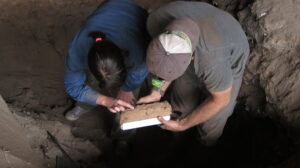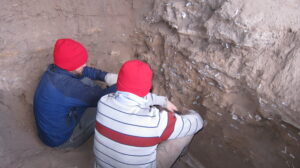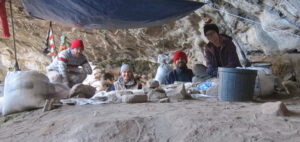Fieldwork Update: Grassridge Rockshelter, Eastern Cape, South Africa
We welcome a guest post from Wenner-Gren grantees Dr. Benjamin Collins and Dr. Christopher Ames.

Dr. Benjamin Collins and Dr. Christopher Ames are currently conducting Wenner-Gren Foundation-funded excavations of the Late Pleistocene and Holocene occupations at Grassridge rockshelter. The site is located at the base of the Stormberg Mountains in the Eastern Cape of South Africa, and is approximately 200 km inland from the Indian Ocean. These excavations are part of the Grassridge Archaeological and Paleoenvironmental Project (GAPP), which explores the dynamic between hunter-gather behavioral diversity, social network formation, and regional-scale climatic variability during the Late Pleistocene.
The Late Pleistocene in southern Africa was subject to periods of severe aridity and rapid climatic change. Some researchers have used this evidence to suggest the interior regions of southern Africa were sparsely populated at these times, with hunter-gatherer groups forming very small, localized social networks. However, the paucity of well-described archaeological sites from the interior during this time frame has made it difficult to explicitly test this hypothesis.

Grassridge’s ~90 – 100 cm thick Late Pleistocene archive is capped by a radiocarbon date of ~35,000 years ago, placing the sequence during an enigmatic period of technological and behavioral diversity in southern Africa. The bottom of the sequence is currently of unknown age. GAPP’s Wenner-Gren Foundation-funded excavations at Grassridge will provide crucial information from the understudied interior region of southern Africa, and make an important contribution towards understanding a period relative uncertainty in the southern African record.
This field season focuses on growing our sample of Late Pleistocene artifacts, and refining the chronology of Grassridge’s Late Pleistocene sequence. Preliminary results demonstrate a rich sample of stone tools, including blades (large and small) and points, faunal remains, several hearths and burning features, and large pieces of ochre. These data provide detailed information about hunter-gatherers lifeways in this area 35,000 years ago, and allow us to compare their strategies with those from across southern Africa.

Our excavations have also recovered substantial charcoal fragments, which are large enough to identify the types of plants being used for fuel, and critical for refining Grassridge’s Late Pleistocene occupational chronology. Moreover, we have identified a thin flowstone at the contact between Grassridge’s Pleistocene and Holocene occupations, which is to be dated by Uranium-Thorium dating specialist, Dr. Robyn Pickering (University of Cape Town). Dr. Pickering’s meticulous analysis will not only provide an important chronological marker, it will also produce detailed information of the paleoenvironmental conditions before, during, and after the formation of the flowstone, and help us better understand the gap in Grassridge’s occupational sequence between the Pleistocene and Holocene.
As our field season comes to a close, we are looking forward to getting back to the lab and analyzing the artifacts and faunal remains recovered from the Late Pleistocene occupation layers, as well as the geological and geochronological samples. These analyses will provide a comprehensive understanding of what life was like for the Grassridge’s hunter-gatherer residents, and more broadly contribute to understanding the relationships between behavioral diversity, social networks, and climatic variability at a regional scale.